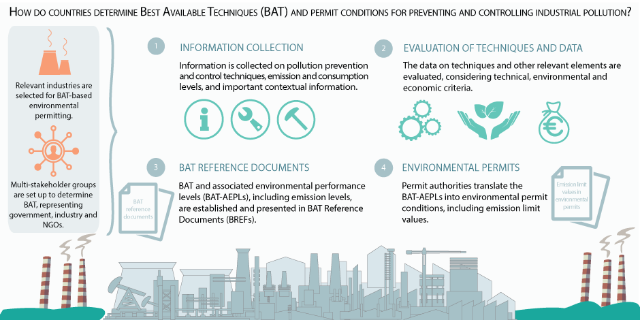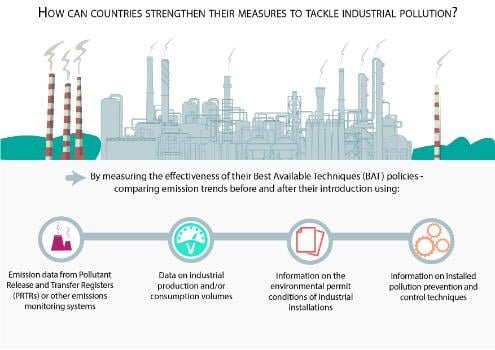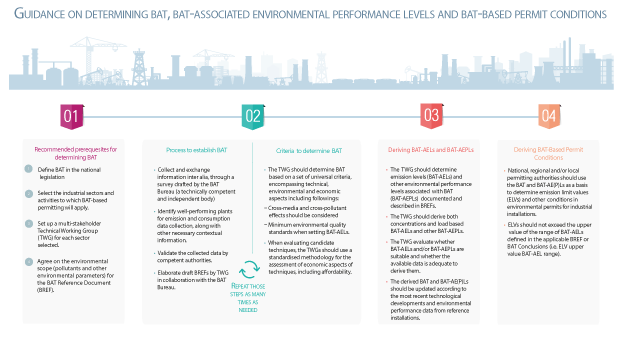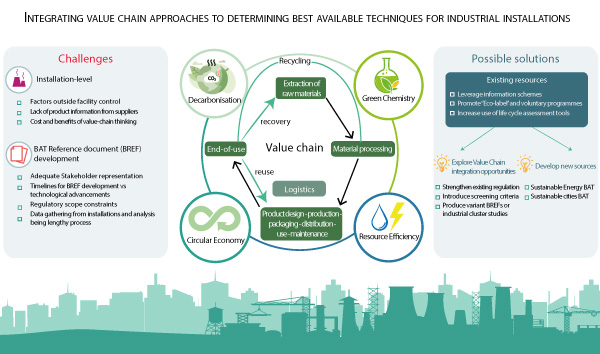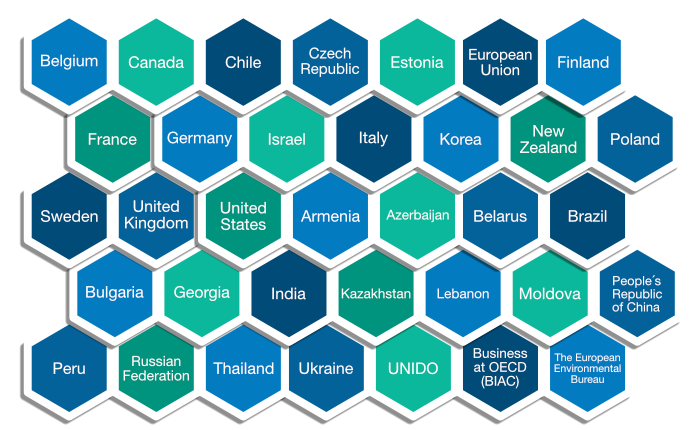Risk management of chemicals
Best Available Techniques (BAT) to Prevent and Control Industrial Pollution
What's new
|
The OECD released a report on Best Available Techniques (BAT) to Prevent and Control Mercury Releases to Land and Water. This study presents a collection of Best Available Techniques (BAT) used for reducing or controlling mercury releases to water and land that are identified across BAT-Reference Documents (BREFS) from several countries. Seven sectors assessed are widely-known for their mercury releases to water and land/soil: large-scale mining, non-ferrous metal, waste (waste treatment, incineration, storage, and disposal), organic chemicals, chlor-alkali production, oil refining and thermal power plant (TPP). This study was undertaken to contribute to the development guidance on Best Available Techniques and Best Environmental Practices (BAT/BEP) for controlling or reducing anthropogenic mercury releases to water and land under Article 9 of the Minamata Convention on Mercury, as well as guidance or mitigation strategies covered under other Articles. |
Why the OECD works on Best Available Techniques (BAT)
An increasing number of countries use BAT as a tool to establish evidence-based environmental permit conditions for industrial installations, in order to prevent and control industrial pollution, and thus ensure a high level of human health and environmental protection. BAT are state-of-the-art techniques that are developed at a scale that enables implementation under economically and technically viable conditions.
Countries spend significant resources on designing, developing and implementing policies for BAT-based permitting. Therefore, there is an added value in sharing experience, knowledge and best practices on this topic amongst OECD member and partner countries. The OECD’s BAT project has so far resulted in the following publications:
- Activity 1: Policies on BAT or Similar Concepts Across the World, 2017
- Activity 2: Approaches to Establishing BAT Around the World, 2018
- Activity 3: Measuring the Effectiveness of Best Available Techniques Policies, 2019
- Activity 4: Guidance Document on Determining Best Available Techniques (BAT), BAT-Associated Environmental Performance Levels and BAT-Based Permit Conditions, 2020
- Activity 5: Value chain approaches to determining Best Available Techniques (BAT) for industrial installations, 2022
- Activity 6: Cross Country analysis of BAT and BAT-associated emission and environmental performance levels in the Thermal Power Plants, Cement and Textile industries, 2022.
The overall objectives of the OECD’s BAT project are to assist governments to implement policies and practices that embody BAT (or similar concepts) to prevent and control industrial pollution, and to contribute to progress towards achieving the Sustainable Development Goals (SDGs).
Publications
|
Activity 1: Policies on BAT or Similar Concepts Across the World, 2017 |
Activity 2: Approaches to Establishing BAT Around the World, 2018 |
Activity 3: Measuring the Effectiveness of BAT Policies, 2019 |
Missed the OECD webinar on integrating value chain approaches to determining BAT for industrial installations? Watch the webinar replay
|
All over the world, different policies and practices are being implemented to prevent and control industrial emissions in order to ensure a high level of environmental and human health protection. Many of these policies incorporate the concept of best available techniques (BAT) to establish evidence-based environmental permit conditions for industrial installations. However, consideration of value chain aspects in the determination of BAT is not a systematic practice.
The OECD report on Value chain approaches to determining Best Available Techniques (BAT) for industrial installations demonstrates that more systematic consideration of value chain aspects in the BAT determination process can help mitigate overall environmental impacts. On 5 May 2022, the OECD hosted a webinar to discuss how to incorporate value chain approaches in BAT determinations and related environmental regulatory concepts as well as the challenges faced and possible solutions. |
Speakers and presentations:
- Introduction: Koki Takaki from the OECD Environment Directorate
- Value chain and its concepts: Sandra Gaona from US Environmental Protection Agency (US-EPA)
- Challenges faced and possible solutions for integrating value chain approaches to national BAT policies: Berrak Eryasa from the OECD Environment Directorate
- Value chain impacts for textiles consumption in the EU and related policies: Lars Mortensen from European Environment Agency (EEA)
- Rethinking business models for the fashion industry: Valérie Boiten from Ellen MacArthur Foundation
Access the presentations here.
List of Best Available Techniques Reference Documents (BREFs)
The OECD compiled a list of Best Available Techniques Reference Documents from different jurisdictions according to industrial sectors.
Video interview on the benefits of a BAT-based approach
Infographics
|
How do countries determine Best Available Techniques and permit conditions for preventing and controlling industrial pollution?
|
How can countries strengthen their measures to tackle industrial pollution? |
|
Infographic: Guidance Document on Determining BAT, BAT-Associated Environmental Performance Levels and BAT-Based Permit Conditions
|
Infographic: Integrating value chain approaches to determining BAT for industrial installations |
Who is involved |
Forthcoming activities for 2019-2021OECD member and partner countries have given their support for the BAT project to continue for the period of 2019-21. With the completion of Activity 4 – Guidance on Determining BAT, the project has the following two on-going objectives:
|
With the financial assistance of the European Union
 The OECD BAT project has been produced with the financial assistance of the European Union. The views expressed herein can in no way be taken to reflect the official opinion of the European Union.
The OECD BAT project has been produced with the financial assistance of the European Union. The views expressed herein can in no way be taken to reflect the official opinion of the European Union.
Engage with us
- For more information, please contact: [email protected]
- Stay tuned on Twitter: @OECD_ENV
- To receive our latest news, publications and events, sign up to the Chemical Safety and Biotechnology Update newsletters
- Watch our videos on our YouTube channel
Related Documents
